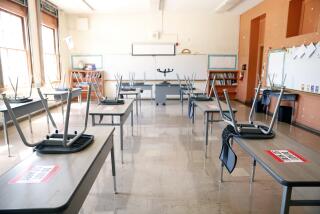Action, Not Words, Key to Reading
- Share via
It is welcome news that reading has become a priority with everyone including our new governor. New demands that kids be “reading by age 9” are trumpeted in the halls of the Legislature, at PTA meetings, and in the pages of our newspapers.
But just in case there are any doubts out there, I’d like to add another reason to the stack. Putting it bluntly, unless major reforms materialize, a child who does not read effectively before junior high school can just about kiss that skill goodbye.
Educators still care about reading in the upper grade levels, but current conditions make it nearly impossible to address this problem adequately.
For one thing, the nature of reading problems changes considerably in the upper grades. By about the 6th grade, there are still some students who have not learned to decode words, but they are in the minority and will typically qualify for special education classes.
The majority of students at this age level who have reading difficulties can read the words; they just can’t make much sense out of them. And at this point, comprehension is critical to success in every subject--from English and government to geography and biology. The focus shifts from “learning to read” to “reading to learn.”
Some students with reading problems somehow manage go undetected, but most are identified by teacher observations, individual reading assessments, standardized tests and parental input.
Once identified, the next challenge is to get kids enrolled in a remedial reading class. Reading courses are often electives rather than requirements. Furthermore, these reading programs might be offered only to freshmen, and after that students are on their own, even if their problem is far from solved.
Say the student with reading difficulties is dutifully placed in a remedial reading program. Can we now assume success is just around the corner? Hardly.
First, the sheer size of so many classes at the upper levels compromises most attempts at an effective reading program. I know it sounds like a broken record, but 38 students in a remedial reading class (the initial size of the classes at my school) is insane. Strategies that require any sort of small group or individual attention aren’t possible.
In addition, reading classes aren’t always taught by specialists, nor are the teachers always required to adapt their teaching to current reading research. Many instructors may do the best they can, but with the usual high numbers and little training it’s easy to be overwhelmed. Accurate assessments of school reading programs are rarely conducted, and some teachers create their own “kingdom” with little or no accountability to anyone. Many teachers report that the students “seem to improve” or that they “think the program is working,” but there is no hard data to back this up.
Most junior high and high school reading programs offer a “group approach,” and if that approach isn’t addressing a particular student’s problem, that student is not going to improve, despite months or even years of remediation. Beyond the need for actual reading classes for students with serious problems, there are many other students in junior high and high school who need assistance with reading in the various content areas. There are different skills required to comprehend a science or history text, for example, as opposed to a novel or short story. The truth is, most teachers have never had any training in how to help students read effectively in their particular subject area.
Again, it’s not that teachers don’t care about reading, but they need to learn how to identify problem readers and what the nature of that problem is. They also need to know if students can comprehend the textbook they are using and what to do about it if they can’t. There also has to be some solid way to assess reading progress or all efforts are a waste of time.
Unfortunately, too many schools are trying to address this problem with platitudes and a “quick fix.” For example, one district, in response to abysmal reading scores on the recent state test, simply gave every teacher a directive to “make reading a priority” in all classes. Nice idea, but with no real training, huge class sizes, and a ton of other material to cover, teachers can’t begin to address reading. Teachers recognize such directives as merely lip service and thus ignore them.
Tackling the reading issue requires specialized teacher training, which is going to take a lot of time and resources. A problem this profound needs adequate materials, realistic class sizes, and more than a few in-service days. Furthermore, if reading is to become a priority, something else has to give. You can’t simply ‘add on” something this critical to an already crammed schedule.
There are junior high and high schools out there trying their darndest to help remedial readers and there are also many districts that realize they need to do a whole lot more. But as it stands now, there are few effective programs in place. As one high-level administrator put it, “If a kid isn’t reading well by fifth grade, not a whole lot is going to happen after that point.”
Such statements should send a chill through the community. Clearly, the goal of having all children “reading by 9” is a worthy one, but that doesn’t mean we call it quits after that. This problem can be addressed if the governor, school districts, administrators and teachers come up with serious solutions that are given a real chance to work.


